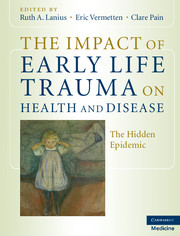Crossref Citations
This Book has been
cited by the following publications. This list is generated based on data provided by Crossref.
Kapfhammer, Hans-Peter
2010.
Psychosomatische Medizin – Geschichte, Definition, Extension, Organisation.
Psychiatrie und Psychotherapie,
Vol. 6,
Issue. 4,
p.
216.
Schaverien, Joy
2011.
BOARDING SCHOOL SYNDROME: BROKEN ATTACHMENTS A HIDDEN TRAUMA.
British Journal of Psychotherapy,
Vol. 27,
Issue. 2,
p.
138.
Mooren, Trudy
2011.
Ouders en kinderen samen: meergezinsbehandeling van vluchtelingen met complexe traumaklachten.
Psychologie & gezondheid,
Vol. 39,
Issue. 3,
p.
169.
Narvaez, Darcia
2011.
Moral Education and Development.
p.
31.
Tehrani, Noreen
Osborne, Diana
and
Lane, David
2012.
Restoring meaning and wholeness – the role for coaching after a trauma.
International Coaching Psychology Review,
Vol. 7,
Issue. 2,
p.
239.
Mabunda, Mikateko
and
Idemudia, Erhabor S.
2012.
Cumulative Adversities and Mental Health of Employees in Workplace Settings in Gauteng Province, South Africa.
Journal of Social Sciences,
Vol. 33,
Issue. 2,
p.
189.
Brown, Carole Koepke
2012.
Estelle L’Hardy’s Ecstatic State and Jenny Wren’s Blessed Children.
Cahiers victoriens et édouardiens,
Brand, Bethany L.
Lanius, Ruth
Vermetten, Eric
Loewenstein, Richard J.
and
Spiegel, David
2012.
Where Are We Going? An Update on Assessment, Treatment, and Neurobiological Research in Dissociative Disorders as We Move Toward theDSM-5.
Journal of Trauma & Dissociation,
Vol. 13,
Issue. 1,
p.
9.
Johnson, Wendy
2012.
Developmental genetics and psychopathology: Some new feathers for a fine old hat.
Development and Psychopathology,
Vol. 24,
Issue. 4,
p.
1165.
Van Leeuwen, Willemijn
Nilsson, Sofia
and
Merlo, Juan
2012.
Mother's country of birth and prescription of psychotropic medication in Swedish adolescents: a life course approach.
BMJ Open,
Vol. 2,
Issue. 5,
p.
e001260.
Shonkoff, Jack P.
Richter, Linda
van der Gaag, Jacques
and
Bhutta, Zulfiqar A.
2012.
An Integrated Scientific Framework for Child Survival and Early Childhood Development.
Pediatrics,
Vol. 129,
Issue. 2,
p.
e460.
Manzano-Mojica, Joel
Martínez-Taboas, Alfonso
Sayers-Montalvo, Sean K.
Cabiya, José J.
and
Alicea-Rodríguez, Larry E.
2012.
Dissociation in Sexually Abused Puerto Rican Children: A Replication Utilizing Social Workers as Informers.
Journal of Trauma & Dissociation,
Vol. 13,
Issue. 3,
p.
330.
Kirkengen, Anna Luise
and
Thornquist, Eline
2012.
The lived body as a medical topic: an argument for an ethically informed epistemology.
Journal of Evaluation in Clinical Practice,
Vol. 18,
Issue. 5,
p.
1095.
Spiegel, David
Lewis-Fernández, Roberto
Lanius, Ruth
Vermetten, Eric
Simeon, Daphne
and
Friedman, Matthew
2013.
Dissociative Disorders in DSM-5.
Annual Review of Clinical Psychology,
Vol. 9,
Issue. 1,
p.
299.
Knox, Jean
2013.
The Mind in Fragments: The Neuroscientific, Developmental, and Traumatic Roots of Dissociation and Their Implications for Clinical Practice.
Psychoanalytic Inquiry,
Vol. 33,
Issue. 5,
p.
449.
Knox, Jean
2013.
The Analytic Institute as a Psychic Retreat: Why We Need to Include Research Evidence in Our Clinical Training.
British Journal of Psychotherapy,
Vol. 29,
Issue. 4,
p.
424.
Olivetti, Katherine
2013.
The Brain and Its Relationship to Mind.
Jung Journal,
Vol. 7,
Issue. 4,
p.
62.
Vermetten, Eric
and
Olff, Miranda
2013.
Psychotraumatology in the Netherlands.
European Journal of Psychotraumatology,
Vol. 4,
Issue. 1,
Bos, Peter A.
Montoya, Estrella R.
Terburg, David
and
van Honk, Jack
2014.
Cortisol administration increases hippocampal activation to infant crying in males depending on childhood neglect.
Human Brain Mapping,
Vol. 35,
Issue. 10,
p.
5116.
Rivera-Vélez, Giselle M.
González-Viruet, Maribella
Martínez-Taboas, Alfonso
and
Pérez-Mojica, Deborah
2014.
Post-Traumatic Stress Disorder, Dissociation, and Neuropsychological Performance in Latina Victims of Childhood Sexual Abuse.
Journal of Child Sexual Abuse,
Vol. 23,
Issue. 1,
p.
55.



